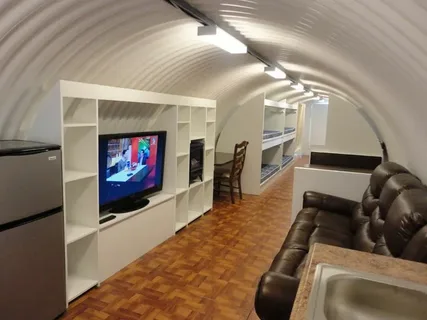In many HDB flats and residential units in Singapore, bomb shelters are often repurposed as storage rooms. While they provide a convenient space to keep household items, using the right storage rack for bomb shelter settings is essential to maximise space efficiently and ensure compliance with safety regulations.
Two common types of bomb shelter racks are heavy-duty and compact models. Each has unique strengths, and choosing the right one depends on your space, storage needs, and preferences. Let’s explore the purpose of bomb shelter racks and what to consider when selecting the best fit.
Understanding the Function of Bomb Shelter Racks
Purpose of Bomb Shelter Racks
Bomb shelter racks are designed to help organise a variety of items such as emergency supplies, tools, canned goods, bottled water, and even daily-use items. This makes it easier for households to access what they need without creating clutter or safety hazards.
Challenges of Limited Space
Most bomb shelters in HDB flats range from only 2 to 4 square metres, which can be quite limiting if not used strategically. Stacking boxes or items on the floor quickly leads to disorganisation and wasted space.
SCDF Guidelines and Safety
The Singapore Civil Defence Force (SCDF) prohibits permanent fixtures or any drilling into the walls of bomb shelters. For this reason, bomb shelter racks must be free-standing and non-invasive. Proper racks allow for air circulation, safe load distribution, and prevent accidents.
Benefits of Using Racks Over Boxes
Racks allow vertical storage and better categorisation, ensuring safer and more accessible storage compared to floor-stacked boxes, which can tip over and obstruct movement.
What Is a Heavy-Duty Bomb Shelter Rack?
Heavy-duty racks are constructed from strong materials like steel, often supporting loads of 200 to 400 kg per tier. They are engineered for stability and long-term usage.
Ideal Use Cases
- Storing emergency supplies like bottled water and canned food
- Housing large power tools or backup electrical devices
- Long-term storage of heavy items
Advantages
- High load capacity: Can support bulky, heavy items without bending or collapsing
- Durability: Made to last, especially under harsh or heavy-use conditions
- Secure storage: Minimises shifting and falling of stored items
Disadvantages
- Takes up more space: May not be suitable for smaller bomb shelters
- Less flexible: Harder to move or reconfigure once set up
- Heavy to install: May require assistance for setup or repositioning
It’s Best For
Homeowners with significant storage needs who want a stable and long-lasting solution.
What Is a Compact Bomb Shelter Rack?
Compact racks are typically made from lighter materials such as aluminium or coated wire. They have a slimmer profile and are often adjustable or stackable for custom configurations.
Ideal Use Cases
- Daily-use items like toiletries, paper products, and medicines
- Important documents or electronics
- Occasional-use items or lightweight tools
Advantages
- Space-saving: Ideal for tight quarters
- Easy to install or move: Lightweight and tool-free assembly
- Budget-friendly: Generally more affordable than heavy-duty models
Disadvantages
- Lower load capacity: Not designed for heavy or bulky items
- Less durable: May wear out faster with repeated heavy use
Best For
Households with minimal storage needs or those looking for a short-term and flexible solution.
Factors to Consider When Choosing a Rack
Storage Needs
Evaluate what you plan to store. Heavy items like bottled water and tools require heavy-duty racks, while light supplies can be managed with compact options.
Frequency of Access
Do you need to access the items regularly? If yes, choose racks with easy access and open shelving. For emergency-only storage, stability may be more important.
Available Space
Measure the available floor and vertical space in your bomb shelter. This helps you determine the dimensions and number of tiers suitable for your setup.
Weight-Bearing Requirements
Make sure the rack you choose can safely hold the total weight of the items you intend to store.
Flexibility vs Permanence
Consider whether you need a fixed setup or something you can adjust and reconfigure easily over time.
Budget and Longevity
Invest based on your long-term storage needs. Heavy-duty racks are more costly but last longer, while compact racks are economical for short-term use.
Rack Safety and Installation Tips
Avoid Drilling
Always adhere to SCDF regulations and avoid drilling or mounting anything onto the shelter walls.
Use Non-Marking Feet
Place rubber stoppers or non-marking feet under rack legs to prevent damage to the flooring and improve grip.
Ensure Ventilation and Accessibility
Keep the entrance clear and allow enough space for air to circulate inside the shelter. Never block ventilation points.
Distribute Weight Evenly
Arrange heavy items on the lower tiers and lighter items higher up to prevent tipping and improve stability.
Make the Right Storage Choice for your Bomb Shelter Rack
Both heavy-duty and compact bomb shelter racks have their place, depending on your storage habits, space, and safety priorities. A well-chosen storage rack for bomb shelter use can help you make the most of your shelter’s space without compromising safety or accessibility.
Need SCDF-compliant bomb shelter racks? Contact Aracking & Shelving Solutions and speak to our storage specialists for tailored advice to suit your home.

